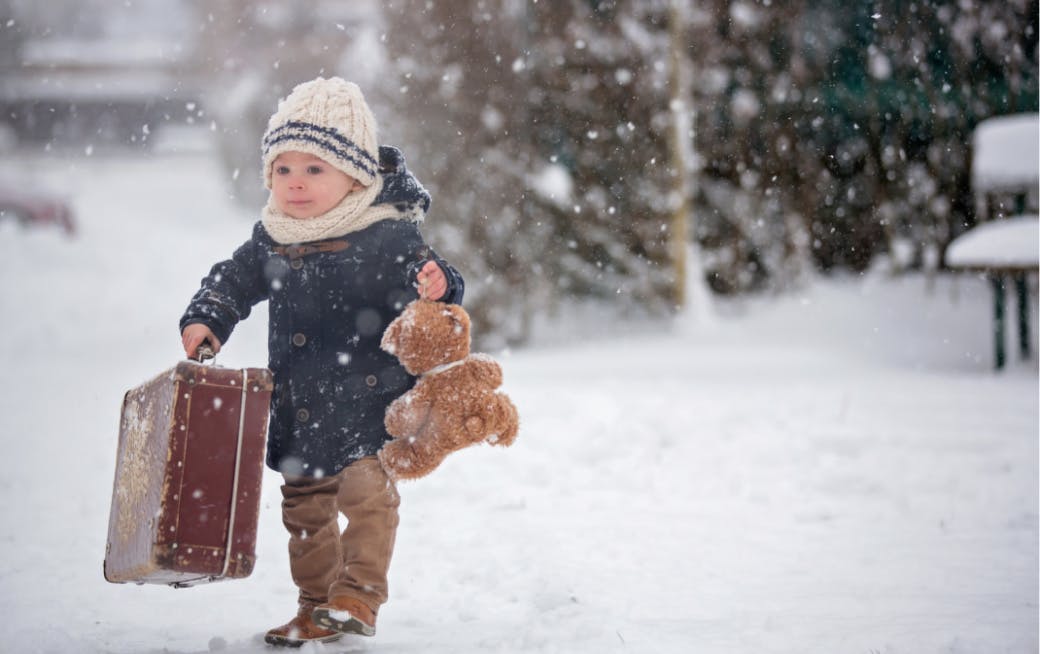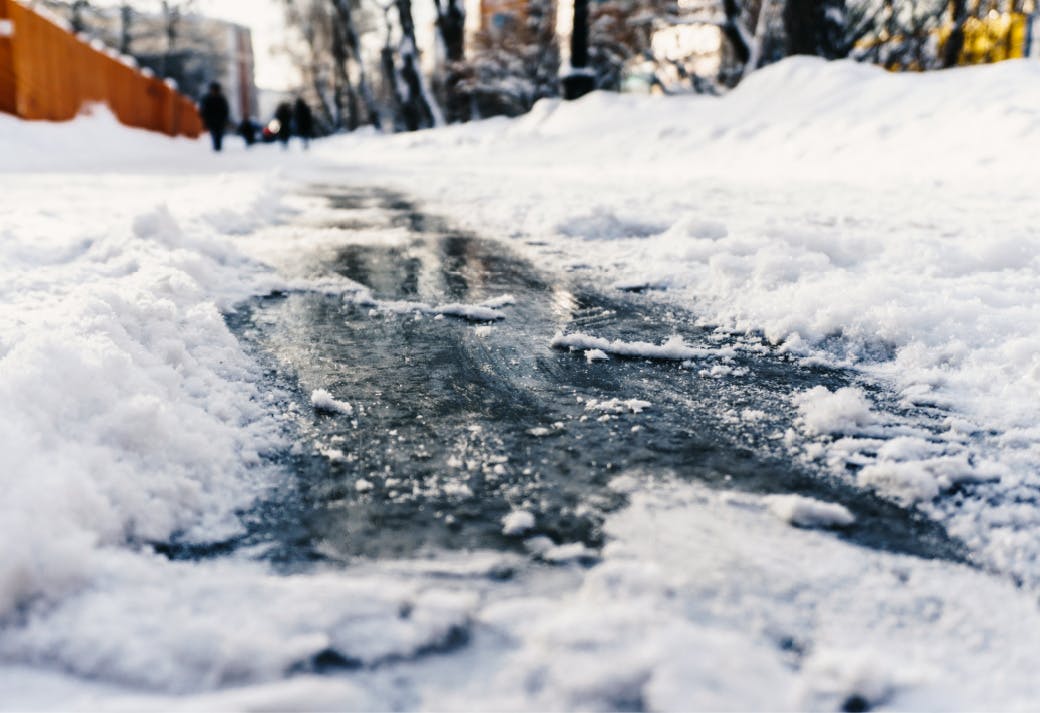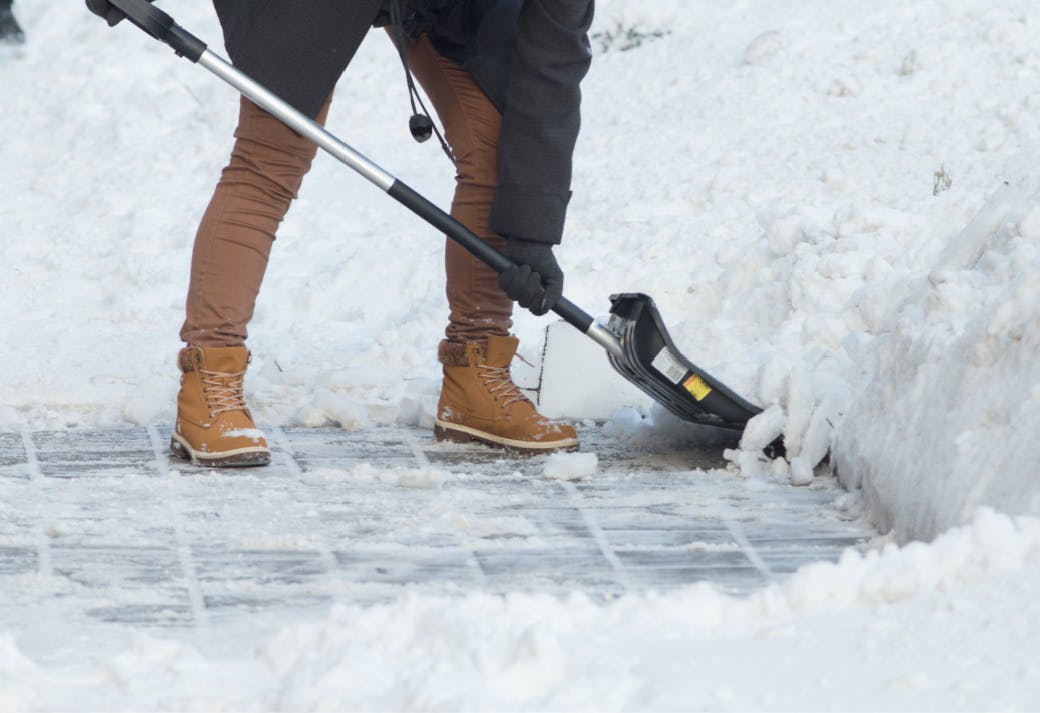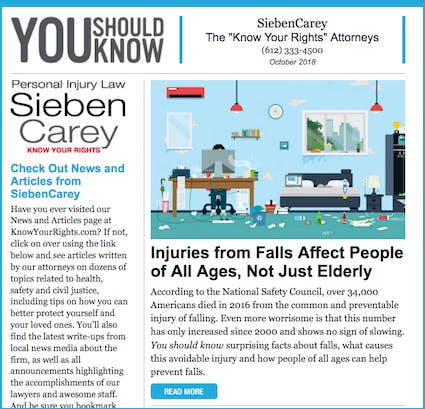Staying Safe Around Ice and Snow

A Minnesota winter landscape can truly be a sight to behold. But where there’s ice, snow, and slush, there’s a chance of injury. Slippery parking lots, sidewalks, driveways, streets, and even yards all pose serious risks if you aren’t careful.
Here are a few tips to keep you safe when you’re out walking in a winter wonderland.
1. Plan ahead.
Don’t just rush out into the cold and hope for the best. Before you go anywhere, take the time to plan your route. Find out what the safest path will be with the least chances of ice or snow, then stick to it.
2. Wear the right shoes.

Whenever you venture out into a world of snow and ice, make sure you have the right footwear for the job. Boots will often offer better security, but shoes can be safe too. Either way, as a general rule, rubber or neoprene composite soles provide much better traction on ice and snow than leather or plastic.
Opt for water-resistant footwear with good insulation, too. Having wet, numb feet will only make navigating slippery surfaces more difficult.
3. Keep your hands free for balance.
If possible, use a backpack to carry items when you’re walking near ice or snow, and keep your hands out of your pockets. You’ll want your hands and arms free if you need to steady yourself or grab onto something.
4. Be aware of your surroundings.
Whenever you’re walking in an area with ice or snow, stay vigilant and aware. Always be alert for any sign of slickness. Ice can be almost invisible, and you want to know it’s there before you’re already taking a tumble.
In order to be truly vigilant, avoid distractions as much as possible. That means leaving your phone in your pocket and keeping your eyes on the path in front of you.
Take it slow, too. Fight the temptation to run to catch a bus or beat traffic when crossing a street. That’s exactly the opportunity those unseen patches of ice are waiting for to trip you up.
5. Watch out for black ice.

Black ice forms when pooled water freezes on pavement, leaving a thin sheet of transparent glaze ice on roads and other surfaces.
Because of its transparency and a common lack of standard ice or snow nearby, it can be easy to overlook it until it’s too late. Even if you do spot a patch of black ice, it may appear to just be a puddle of water or dampness. In reality, it’s a recipe for slipping and falling.
Always pay close attention to where you’re stepping, and any time you see what appears to be just a damp spot on the pavement, double-check to be sure it isn’t a thin layer of black ice.
6. Walk carefully.
Take your time and test any potentially slippery places by tapping them with your boot or shoe. If an area is slick, go around it if possible. When there’s no option but to cross the ice, however, you’ll need to change how you walk:
- Step slowly and deliberately.
- Take short, shuffling steps, and curl your toes under and walk as flat-footed as possible.
- Walk “small.” Avoid an erect, marching posture.
- Spread your feet out slightly like a penguin. Walking like a penguin increases your center of gravity, making it easier to maintain your balance.
- Be ready to react quickly to changes in traction.
Then, once you’re past the patch of ice, slush, or frozen snow, keep your eyes open and stay attentive to what’s in front of you.
7. Be careful when entering or exiting vehicles.

Many wintertime slip-and-fall injuries happen while climbing in or out of a car or other vehicle. To avoid this, start by being mindful of where you park to try to make sure you won’t be stepping out onto a patch of ice, slush, or snow.
Once you’ve parked in what seems to be a safe place, exit the vehicle with caution. Hold onto something to support yourself when getting out, and test the ground before you trust your footing.
Be just as careful when you return to your vehicle, too.
8. Don’t let your guard down when you go inside.
Even when you come in from the cold, stay alert. People can track plenty of snow and slush inside, and the puddles left behind can be fall hazards for everyone. Plus, any snow or water on the soles of your shoes or boots may make you lose your balance once you’re on smooth indoor flooring, such as stone, tile, or hardwood.So when entering buildings or home, clean your feet on rugs or mats as quickly as possible. Watch for any slippery floors or steps, and use handrails if you can.
9. Prevent ice on and around your property.

You can’t get rid of ice and snow everywhere, but you can keep it to a minimum close to home. Shovel snow from your porch, sidewalks, steps, or driveway before it gets packed down and turns to ice — or hides ice underneath it. Then, apply ice melt to further reduce the chances of slipping and falling.
10. Know what to do if you fall.
Taking care to avoid slipping and falling is always the best way to avoid injury. However, if you do fall, it’s important to know how to respond.
If the fall is serious enough, you may need to call 911 or go to the emergency room immediately. How serious is serious enough? Some signs that you might need emergency care include:
- Not being able to get back up
- Thinking you have a broken bone
- Experiencing severe pain
- Having a head injury that results in loss of consciousness, a major headache, nausea and vomiting, confusion, sleepiness, or seizures
Even if an injury isn’t that extreme, be ready to employ the RICE method. RICE stands for:
Rest: keep as much strain or weight off of the injured area as possible. Sit or lie down if possible.
Ice: Apply a cold pack to the injured area. Leave it in place for no more than 20 minutes.
Compress: Wrap an ACE bandage around the swollen region. Be careful not to cut off circulation, though. If the injured part starts to throb or the wrap is too tight, remove the bandage and re-wrap it a little looser.
Elevate: Elevate the injured area to help control swelling. This is most effective when the injury is kept higher than your heart.
Enjoy the beauty of a Minnesota winter with confidence.
Ice, snow, and slush can be risky, but that’s no reason to stay cooped up at home. Armed with these tips, you can get where you need to go as safely as possible. (You just might have to walk like a penguin sometimes.)
But slippery surfaces always pose some threat, no matter how careful you are. Accidents happen. If you’ve been injured by slipping or falling, you may have a legal claim to compensation.









